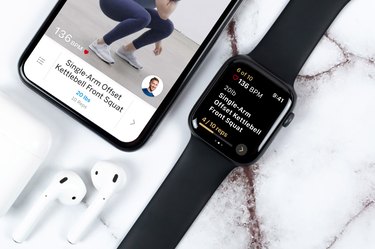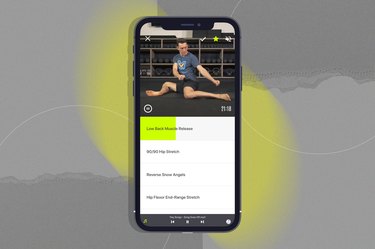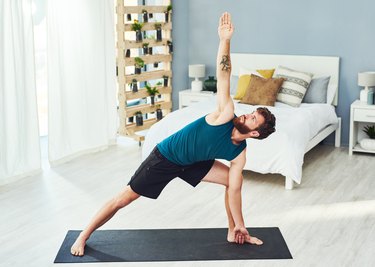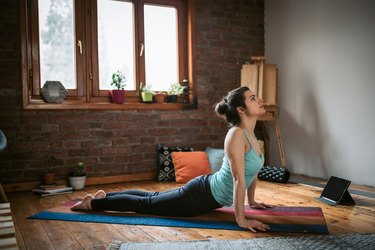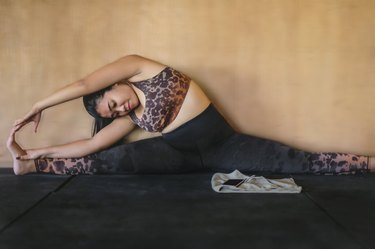
Stretching techniques are hotly debated in the fitness world, particularly when it comes to dynamic versus static stretching. And considering active, dynamic, proprioceptive neuromuscular facilitation (PNF) and other types of stretches already exist, adding hyperbolic stretching to the list can be more confusing than clarifying.
Hyperbolic stretching is an online program that promises to increase flexibility, improve posture and relieve back and hip pain, regardless of age or body type. In fact, the program claims it will help you do a full split in just one month.
Video of the Day
Video of the Day
But is this program legit? We tested the hyperbolic stretching program for four weeks, looked at the research and talked to experts to find out if it lives up to its promises.
What Is Hyperbolic Stretching?
Hyperbolic stretching is the name of a stretching program designed by Alex Larsson, who markets himself as a "flexibility and core strength expert," but his credentials can't actually be found online.
His program combines several methods of stretching, including a form of PNF stretching. With this type of stretching, you use your reflexes to help you get a deeper stretch to improve flexibility. He also includes dynamic stretches (also called active stretches) and some static stretching as well.
According to the website, the program combines "ancient methods of Japanese stretching" with recent advances in Western medicine and research. It relies on the body's "survival reflexes" — really the PNF concept of "hold-relax."
This concept refers to stretching the muscle and then contracting it without moving it, known as an isometric contraction. This triggers a reflex that allows you to move deeper into a stretch.
Here's an example of how that works: Imagine doing a lying hamstring stretch with a workout buddy. Your partner pushes against the back of your calf and ankle, and, at the same time, you push back against their resistance. Then, you relax your leg, allowing their gentle push to deepen your stretch.
The program also involves practicing stretches that mimic the motion you want to improve, as well as strengthening exercises to get your muscles primed for stretching.
But does hyperbolic stretching actually help build flexibility? Let's jump into what the program consists of and our honest review.
The Hyperbolic Program
The Hyperbolic Program is available to purchase online for $37 for instant, digital, lifetime access to the basic stretching program, video guides, online support and a Facebook community. There's also a 60-day, money-back promise if you're not satisfied with your results.
The actual program involves 8 minutes per day of a specific stretching routine, 6 days a week for 30 days to see results.
The goal is to be able to do both the side split or straddle split (both legs split out to the sides) and the front split (one leg is in front and one is behind).
With your purchase, you get access to several videos, including:
- Main Guide: The introduction to hyperbolic stretching, where Larsson goes over the basics of the program, the equipment needed and what to expect.
- Front Split: A series of videos to help you work from beginner status to being able to do a front split.
- Side Split: A series of videos to help you work from beginner status to being able to do a side split.
- Bonus Videos: These cover more on dynamic stretching, upper-body stretching, a pike stretch routine (folding over and touching your toes) and more.
You'll also get a monthly stretching calendar so you can appropriately break up the program.
The only equipment you need is a stable chair and a couple of soft pillows or towels.
Review of the Hyperbolic Stretching Routine
After signing up and paying, I was emailed a link with access to the videos. I was instructed to follow along with the beginner video for week one, a new video for weeks two and three and then a more advanced video for week four. Each week had a short "explainer" video and then the 8-minute stretching routine. As the weeks progressed, the stretches became deeper and more intense.
Even though the routines differ slightly from week to week, they follow the same general format:
- Light warmup, which I would categorize as dynamic stretches, such as standing lunges.
- Active stretches and some passive stretches, which you are instructed to do with gentle bouncing or oscillations. This is called ballistic stretching.
- The "hold-relax" stretch, in which you contract your muscles isometrically, and then go deeper into the stretch.
The main muscles stretched for the side splits are the hip adductors, while you are mainly stretching the hip flexors and hamstrings for the front splits.
I work out frequently, but I don't do a regular stretching routine. I do Pilates twice a week, however, so I was fairly flexible before starting the program.
The stretches are uncomfortable — after all, you are stretching — yet not painful. I had a difficult time with some of the hold-relax stretches for the hip flexors, as you must push down into the ground with your knee, and I found that uncomfortable. However, I was able to use a mat for padding and work around it.
The videos are straightforward and easy to follow. The background music and speaking voice were both a bit monotonous though, especially after following along with the routine for several days.
After each session, my legs, hips and back felt loose and warmed up, similar to a post-yoga feeling — and I actually started looking forward to doing the routines for this reason.
The Results
My flexibility improved quite a bit in four weeks. At the end of the program, I was almost able to do the side splits, and I had pretty much mastered the front splits, though one side was more flexible than the other.
Side Split: Before

Side Split: After
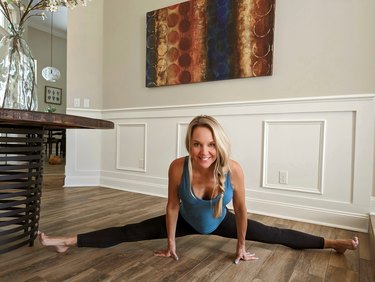
Front Split, Right and Left: Before
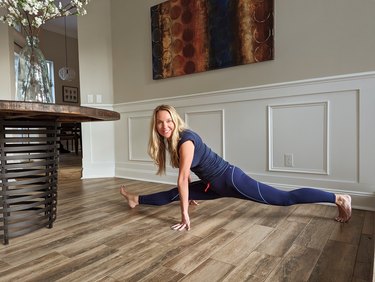
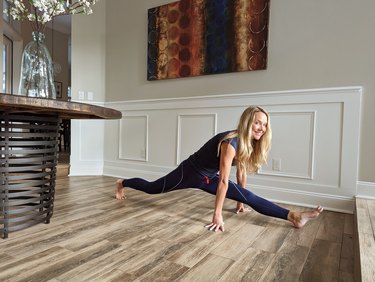
Front Split, Right and Left Sides: After
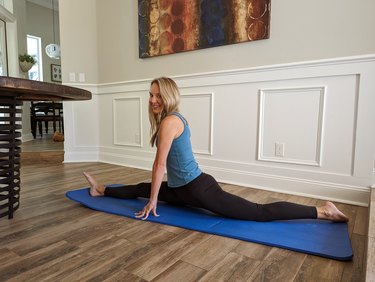
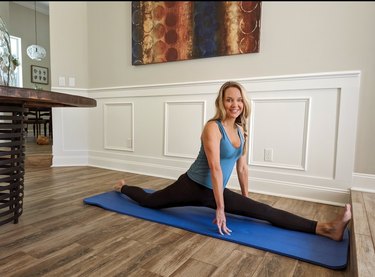
I did have one week during the four-week program where I was out of town, so I didn't do the full six days. That said, I was overall impressed with my flexibility gains.
This program does offer other stretching programs included in the price, including upper body stretches and dynamic stretches, but I did not try those out.
Pros of Hyperbolic Stretching
- Budget-friendly
- Does seem to increase flexibility
- Easy to follow
Cons of Hyperbolic Stretching
- Can become monotonous
- Not likely a beginner will be able to do the full splits after 4 weeks
- Not all of the stretches are backed by science
- Not created by a PT or CPT
What Does the Research Say?
Although being able to do the different types of splits looks cool, it also offers some real benefits. In general, stretching helps prevent injuries and muscle imbalances, promotes relaxation and even helps your muscles perform better, according to the National Academy of Sports Medicine (NASM).
Research shows tight hip flexors and tight hamstrings can contribute to back pain. Stretching for the front splits (and actually doing the front splits) is a great way to stretch both your hip flexors and hamstrings. Keeping these muscles loose may help decrease and prevent back pain.
However, there are several other ways to stretch these same muscles without doing the splits.
This program uses PNF stretching, a form of passive stretching, which a January 2019 meta-analysis in Physical Therapy in Sport found effective in increasing hamstring flexibility.
However, a prior March 2012 study in the Journal of Human Kinetics also found PNF stretching may decrease the performance of high-intensity exercise or sports. For best results, do this stretching program after your sport or athletic activities, not before.
This program also uses ballistic stretching, or bouncing movement with the stretches. Bouncing too forcefully could lead to injury, and many trainers do not recommend ballistic stretching at all. Ballistic stretching is typically not recommended by physical therapists either, because of its link to injuries, per a February 2012 review in the International Journal of Sports Physical Therapy.
You also do some dynamic or active stretches, as well as static stretches — which the NASM says helps increase range of motion, as well as decrease pain and stiffness.
"I am a huge proponent of creating a habit of incorporating active stretching into your weekly routine," says Grayson Wickham, DPT, physical therapist and founder of Movement Vault. "With that said, the hyperbolic stretching program isn't the most effective combination of stretching techniques."
Grayson tells LIVESTRONG.com he is not a fan of passive or static stretching due to its effect on sports and athletic performances. Plus, it doesn't serve much of a functional purpose. "When we look at it from a common sense perspective, why would we passively stretch to help us get better for active movements in life, in the gym and in our sport?"
He says he does like the active or dynamic stretching techniques incorporated in the hyperbolic program, but he notes that the stretches lack variety and the contraction holds should be longer during the "hold-relax" portions of the stretches.
Wickham says it is also important to be realistic about how much flexibility you can gain in four weeks. "I am highly skeptical that someone can go from a beginner to doing splits in four weeks of performing their 8-minute routines," Wickham says.
The splits aren't exactly beginner-friendly. And jumping right into a brand-new stretching program can put you at risk of injury. Plus, the splits aren't really necessary for day-to-day pain-free movement or athletic performance.
The Bottom Line
A regular stretching program has many benefits. Hyperbolic stretching uses PNF stretching techniques in an easy-to-follow format that appears to be effective in increasing lower body flexibility. It also includes some dynamic stretches and static stretches, which have some benefits. At $37, it is a budget-friendly program, and the routines left me feeling relaxed and limber.
As far as being able to do the splits in four weeks, that depends on your starting flexibility and fitness levels, as well as your compliance with the program.
Use caution with the bouncing or ballistic stretching in the program to lower your risk of injury. Unless you're an athlete or have been doing a regular stretching program, you may want to avoid doing ballistic stretches altogether. It would also be better to perform this stretching program after sports or other athletic activities.
This program may not be for everyone, so talk to your doctor if you have a preexisting condition, have had a recent injury or are looking for stretches for older adults.
"Anyone that has had a joint replacement should consult with their physician as to whether specific stretches are appropriate for them," Wickham says. "If you experience numbness, tingling or burning pain during any stretch, you should always either modify the stretch or choose a different stretch."
If you need a dedicated and regular routine to motivate you to stretch (and you really want to do the splits!), then this program would be beneficial. However, you could also do your own stretching sequence on a regular basis to get similar results.
- Journal of Human Kinetics: "Proprioceptive Neuromuscular Facilitation (PNF): Its Mechanisms and Effects on Range of Motion and Muscular Function"
- NASM: "5 Huge Benefits of Stretching: Learn the Advantages of Flexibility"
- International Journal of Environmental Research and Public Health: "The Influence of Stretching the Hip Flexor Muscles on Performance Parameters. A Systematic Review with Meta-Analysis"
- British Journal of Sports Medicine: "A Comparative Study of Static Stretching Versus Ballistic Stretching on the Flexibility of the Hamstring Muscles of Athletes "
- BMC Musculoskeletal Disorders: "Restriction in Lateral Bending Range of Motion, Lumbar Lordosis, and Hamstring Flexibility Predicts the Development of Low Back Pain: A Systematic Review of Prospective Cohort Studies"
- NASM: "Is Static Stretching Effective for Injury Prevention?"
- Physical Therapy in Sport: "Hold-relax and contract-relax stretching for hamstrings flexibility: A systematic review with meta-analysis"
- International Journal of Sports Physical Therapy: "CURRENT CONCEPTS IN MUSCLE STRETCHING FOR EXERCISE AND REHABILITATION"
